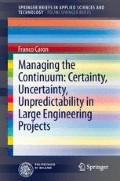Abstract
The traditional approach to Project Management focuses on the stability of the project plan as a critical success factor. However the increasing level of complexity and uncertainty in the business context requires a high level of adaptability to changes.
Access this chapter
Tax calculation will be finalised at checkout
Purchases are for personal use only
References
I. Ansoff, Managing strategic surprise by response to weak signals. Calif. Manage. Rev. 18(2), 21–33 (1975)
K. Artto, J. Kujala, P. Dietrich, M. Martinsuo, What is project strategy. Int. J. Project Manage. 26, 4–12 (2008)
K. Artto, M. Lehtonen, K. Aaltonen, P. Aaltonen, J. Kujala,S. Lindemann, M. Murtonen M., Two types of project strategy–empirical illustrations in project risk management, IRNOP IX, October 2009 (Berlin, 2009)
E.S. Bernardes, M.D. Hanna, A theoretical review of flexibility, agility and responsiveness in the operations management literature. Int. J. Oper. Prod. Manage. 29(1), 30–53 (2008)
B.J. Kolltveit, J.T. Karlsen, K. Gronhaug. Exploiting opportunities in uncertainty during the early project phase. J. Manage. Eng. (2004). ASCE
P. Davidson, Is probability theory relevant for uncertainty? A post Keynesian perspective. J. Econ. Perspect. 5(1), 129–143 (1991)
S. Floricel, R. Miller, Strategizing for anticipated risks and turbulence in large scale engineering projects. Int. J. Proj. Manage. 19, 445–455 (2001)
D.N. Ford, S. Bhargav, Project management quality and the value of flexible strategies. Eng. Constr. Architectural Manage. 23(3), 275–289 (2006)
J.G. Geraldi, L. Lee-Kelley, E. Kutsch, The balance between order and chaos in multi project firms: A conceptual model. Int. J. Proj. Manage. 28, 547–558 (2010)
M. Hellstrom, K. Wikstrom, Project business concepts based on modularity—improved manouevrability through unstable structures. Int. J. Proj. Manage. 23, 392–397 (2005)
M. Loosemore, Managing project risks, in The management of complex projects: A relationship approach, ed. by S. Pryke, H. Smyth (Blackwell Publishing, Oxford, 2006)
R. Miller, D. Lessard, The strategic management of large engineering projects, shaping institutions, risks and governance (MIT, Cambridge, 2000)
P.W.G. Morris, A. Jamieson, Moving from corporate strategy project strategy. Proj. Manage. J. 36(4), 5–18 (2005)
N.O.E. Olsson, Management of flexibility in projects. Int. J. Proj. Manage. 24, 66–74 (2006)
N.O.E. Olsson, External and internal flexibility—aligning projects with the business strategy and executing projects efficiently. Int. J. Proj. Organ. Manage. 1(1), 47–64 (2008)
N.O.E. Olsson, O.M. Magnussen, Flexibility at different stages in the life cycle of projects: An empirical illustration of the freedom to maneuver. Proj. Manage. J. 38(4), 25–32 (2007)
A.M. Ross, D.H. Rhodes, D.E. Hastings, Defining changeability: Reconciling flexibility, adaptability, scalability, modifiability, and robustness for maintaining system lifecycle value. Syst. Eng. 11(3), 246–262 (2008)
A.P. Schulz, E. Fricke, Incorporating flexibility, agility, robustness and adaptability within the design of integrated systems—key to success? Digit. Avionics Syst. Conf. 1, 1–17 (1999)
Author information
Authors and Affiliations
Corresponding author
Rights and permissions
Copyright information
© 2013 The Author(s)
About this chapter
Cite this chapter
Caron, F. (2013). Robustness and Flexibility. In: Managing the Continuum: Certainty, Uncertainty, Unpredictability in Large Engineering Projects. SpringerBriefs in Applied Sciences and Technology(). Springer, Milano. https://doi.org/10.1007/978-88-470-5244-4_6
Download citation
DOI: https://doi.org/10.1007/978-88-470-5244-4_6
Published:
Publisher Name: Springer, Milano
Print ISBN: 978-88-470-5243-7
Online ISBN: 978-88-470-5244-4
eBook Packages: EngineeringEngineering (R0)

